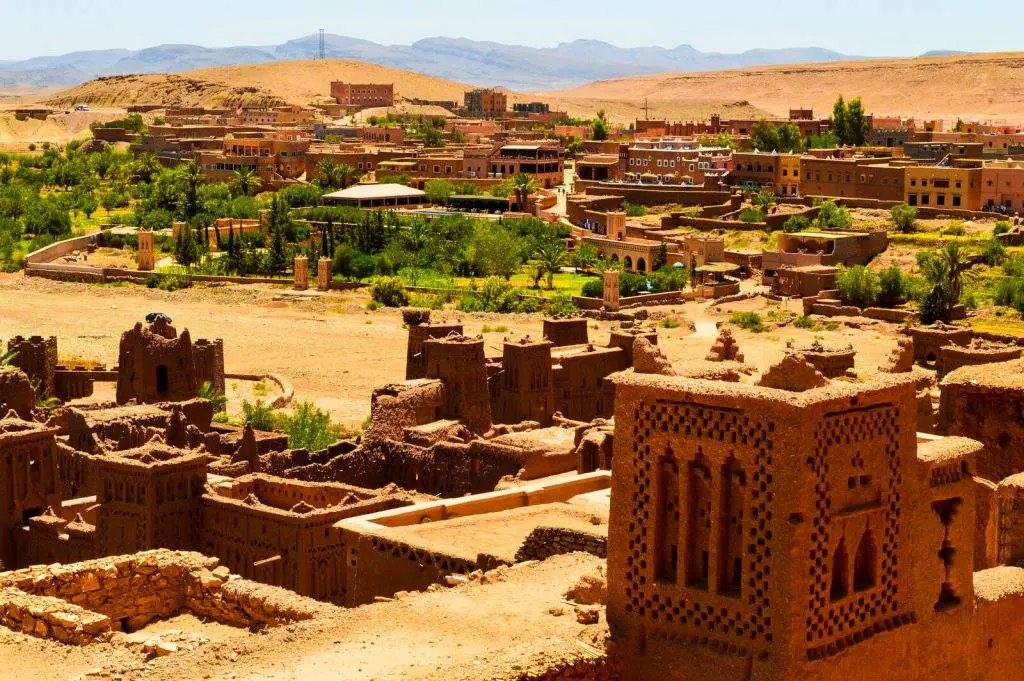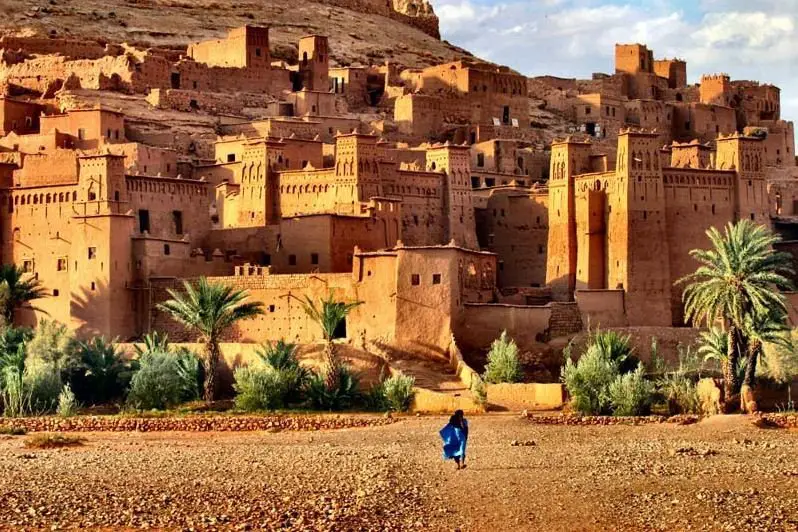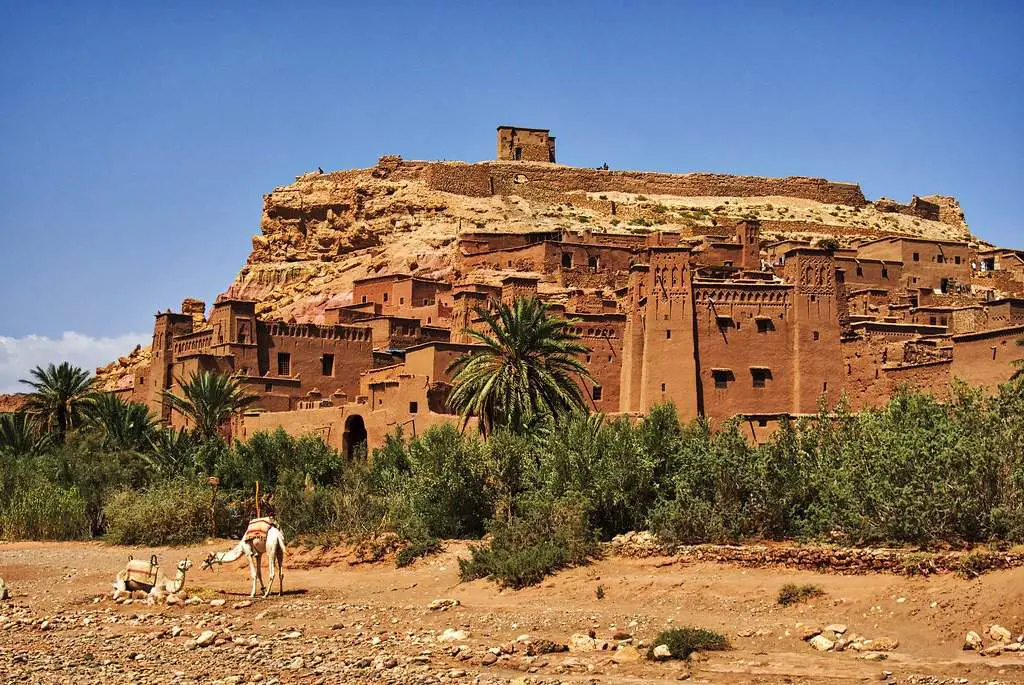You will have seen it a few times when preparing your trip to Morocco, and from the first moment it was surely very familiar to you: the Kasbah of Ait Ben Haddou (or rather the Ksar) is probably the most famous building in all of Morocco.
Its fame is such that it was the set for films such as Lawrence of Arabia, The Mummy, Gladiator, Prince of Persia and even became the city of Yunkai in Game of Thrones.

In this post we tell you how to visit Ait Ben Haddou and give you a few useful tips.
What is the difference between Kasbah and Ksar? A Kasbah is a single palace where some wealthy family resided. While a Ksar is a walled village, something like a citadel, formed by different buildings. So a ksar can contain several kasbahs within its boundaries.
The Ksar of Ait Ben Haddou
The Ksar of Ait Ben Haddou owes its name to the tribe that settled in these lands, and that began its construction back in the 17th century (Ben= “sons”: Sons of Haddou).
They took advantage of the slope of a hill to pile up small houses made of adobe, some quite modest and others that look like authentic castles (kasbahs). It was a place frequented by the caravans of merchants who embarked on the route between Marrakech and the cities on the other side of the Sahara, in a journey that lasted several months.
With the passage of time the citadel was depopulated, although many of its buildings were preserved almost intact, making it one of the best examples of medieval Berber pre-Saharan citadel.
The fact that it was named a UNESCO heritage site in 1987 and that it has been the setting for many high-budget films has also helped it to look like one of the wonders of Morocco today.

Ait Ben Haddou is the most iconic “fortified town” or ksar/Kasbah in Morocco, in the province of Ouarzazat, in the Draa-Tafilalet region of southern Morocco.
This ksar, or fortified adobe village, is an interesting place to say the least, the setting for the filming of many cinematic gems and home to the ancestral Moroccan architecture.
The Morocco that, in short, precedes the infinite Sahara desert, the largest in the world.
A Little Background
The ksar or fortified villages in adobe, stopped in time, are like a beautiful relic in the middle of nowhere. Designed to defend the harvest and the palm groves that grew along the rivers, they are rectangular walled enclosures with four corner towers, inside which the tiny houses, courtyards and alleys were piled up. That of Ait Ben Haddou, 30 kilometers before reaching Ouarzazate on the road from Marrakech, is one of the best preserved in the country thanks to some restorations and also to the protection conferred on it by UNESCO in 1987 when it was declared a World Heritage Site. It was not for less. Because in the splendor of its Berber architecture, in the intricate labyrinth of alleys and covered passages that can be accessed after crossing the Ounila River on muleback, lies the intact charm of its origins, when this ksar was a gateway to and from the desert through which often crossed caravans of nomads with camels loaded with exotic products.
Art, Cinema and History
This place is also an image that the cinema has recreated on many occasions, since Ait Ben Haddou has served as a film set in movies like The Jewel of the Nile, Sodom and Gomorrah, Gladiator and some scenes of the legendary Lawrence of Arabia. Its fame may endure thanks to the seventh art, but the truth is that its beauty remains unquestionable.
In the village you can also find Moroccan handicrafts of all kinds: clay pots, iron tools, leather belts, wool, handmade glass and other small treasures.
Ait Ben Haddou is a clear example of southern Moroccan architecture, whose history dates back almost a thousand years. Its condition of obligatory stop for the caravans that, through the commercial route of the Sahara, linked Sudan with the imperial city of Marrakech, via Telouet, gave it an enormous prosperity. The camels carried gold and silver, among other treasures, and returned loaded with salt.
Thousands of people lived in this fortified city that had small palaces, a public square, a mosque, an inn for nomads, a granary at the top of the village and two cemeteries, one Muslim and one Jewish.
Later, the caravans tended to disappear and the population of Ait Ben Haddou dwindled over the years. Today, only a handful of families live in the walled enclosure. Despite the deterioration, its essence remains: the reddish buildings that blend in with the earth, the traditional mud and straw houses, among other peculiarities of their environment.
Getting lost in this adobe labyrinth is an extraordinary experience, a return to the origin of time. And although just by walking you will feel the echoes of antiquity, you must climb the keep of the old Kasba.
Despite being in ruins, it is worth contemplating the panoramic view it provides: from the top you can see the entire semi-desert region and in the background, the snow-capped peaks of the Atlas.
You can take a tour of Ait Ben Haddou by yourself or hire a guide to show you around and explain its history. If you are going to hire a guide it is advisable to fix the price before starting the tour. You can look for these guides by asking at the reception of one of the hotels in the new part.
It is certainly worth visiting the Kasbah of Ait Ben Haddou in detail, entering their houses and seeing their way of life and their constructive and decorative curiosities. It also offers us a glimpse into the past which is not common to find today.
How to visit Ait Ben Haddou on your own
Ait Ben Haddou, is divided into two parts: the old city (which would be the famous ksar) and the new city, with several options for accommodation and restaurants.
It is located about 30 km from Ouarzazate, at the southern end of the Ounila Valley, which crosses a picturesque landscape on the way to Marrakech, and passes through the beautiful Telouet Kasbah.
A few years ago part of the road was a dirt track, but now it is all paved and in perfect condition. So we believe that it is the best route to reach Air Ben Haddou.
The old citadel is separated from the new city by the river Ounila. To get to its feet you will have to cross the river on foot (don’t worry that the level is usually low or null, there is also a bridge).
First you can park your car in a parking lot next to the Hotel La Kasbah, or simply on the main road of the new town. When we visited in September, the river was a tiny trickle in the morning and was directly dry in the afternoon. There are two areas to cross the river:
- Across the relatively newly built bridge (pedestrian only). It is behind the mosque.
- Going down the alleyway to the restaurant La Terrazza and from there jumping over the sacks on the river, or using the stones. If it’s dry you have nothing to worry about.
But first you have to know that there are 3 entrances to cross the ancient walls:
- The first one and the one we used was the one from the new bridge. It is on the left side.
- The second one is more or less in the middle of ksar, and it goes through the most impressive constructions. It is just after the sacks in the river.
- The third one is also after crossing the river by the sacks, but turning right afterwards. There is a path next to a small oasis and you reach an entrance corridor.
In theory the entrance is free, although we were told that it depends on where you enter. If you go through the central entrance, you will pass by a private house and they will ask you for some money (or so they told us at the reception of the hostel).
We entered through the access of the new bridge (first entrance) and left through the one on the right (third entrance) and nobody asked us for anything. We don’t know 100% if the access from the center or even the one on the right is paid.
Once inside the walls, Ait Ben Haddou appears as a set of cobblestone streets, with small houses on both sides, mostly uninhabited, and flights of stairs. It is not a maze, just keep in mind that first you have to go pulling up, to reach the agadir that crowns the citadel, and then down and out, if possible by other streets and another different door.

Among its small houses you will surely see some that stand out from the others: in total there must be about 6 kasbahs (some can be visited, 10 dirhams entrance), some museum, but above all shops where they keep their material or use it as an exhibition.
Of course there are also souvenir stores (the drawings made with tea and saffron are very beautiful and change color when heat is applied are very beautiful!)
From the top of the hill you will have wonderful views of the region, although the best views are those offered by the mountain just in front. You can climb it from a small path that starts next to the third entrance, and it is the ideal place to watch the sunset in front of Ait Ben Haddou.
How to visit Ait Ben Haddou in organized tour
There are both excursions that take you and bring you from Marrakech in the day, as other several days also from Marrakech in which they visit the most important points of this area south of the Atlas.
These are the tours we recommend:
- Visit of Ait Ben Haddou and Ouarzazate of 1 day
- 2 days tour: Ait Ben Haddou, Draa Valley and night in the desert of Erg Chegaga.
- 3 days tour: Ait Ben Haddou, Ouarzazate, Dades and Todra Valleys and night in Erg Chebbi desert.
- 4 days tour: Ait Ben Haddou, Ouarzazate, Dades and Todra Valleys, night in the desert of Erg Chebbi, Berber villages and Draa Valley.
Where to sleep in Ait Ben Haddou
We recommend that you stay overnight in the small village of Ait Ben Haddou to contemplate the old ksar both at sunset from the mountain and to visit it during the next morning.
We stayed at the La Baraka Hostel, which has modest rooms but all the comforts.
There are other Riads more pijetes in the surroundings, for larger budgets.
Where to eat in Ait Ben Haddou
We wanted to go to the Italian restaurant on La Terrazza, mostly to enjoy its clean views of Ait Ben Haddou, but the menu threw us back (pizzas and pastas from 150 dirhams).
So we opted for the Moroccan option and we took a huge and delicious menu at the restaurant and hostel Valentine (110 and 120 dirhams, with salad or soup, main, fruit and tea). The terrace is also very nice and the man very majete.
We hope that these tips will help you in your visit to Ait Ben Haddou, the most famous and best preserved ksar in Morocco.